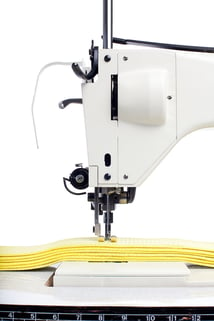 Are skipped stitches causing yous downward fourth dimension in your industrial sewing application? Hither are some tips to help find and correct the common causes of skipped stitches.
Are skipped stitches causing yous downward fourth dimension in your industrial sewing application? Hither are some tips to help find and correct the common causes of skipped stitches.
- Cheque and make certain that machine is threaded correctly
- Make sure car is oiled properly and full general maintenance has been done
- Change the needle and make certain it is pushed all the manner into the needle bar with the kerf/eye parallel to the hand cycle or slightly pointed towards incoming shuttle hook
- Check timing of needle in relation to hook. Brand sure the needle is ascension support when checking the timing. When the tip of the claw is beside the needle, the eye of the needle should be ~ 1/sixteen" below the hook. The tip of the hook should also be very close to the needle, almost the thickness of printer paper from the needle:
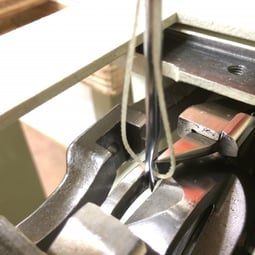
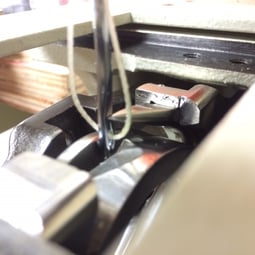
- Make sure the tip of the hook is not damaged or sharpened more than than a few times. Sharpening moves the timing, and eventually to the point of not existence able to go on the car sewing reliably.
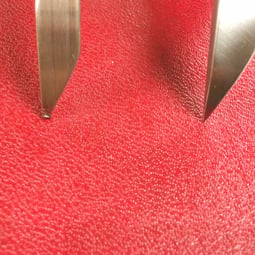
- Make certain the throat plate/needle plate does not take an excessively big pigsty(pic on the right). The hole should be slightly larger than the needle and thread together.
- Check the throat plate for warpage (film on the left)
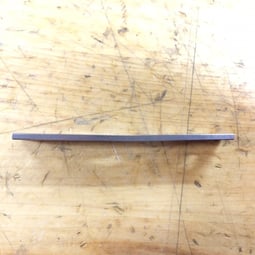
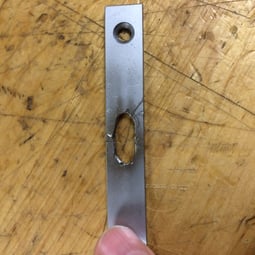
- Make certain the inner presser foot is holding the material sufficiently tight when needle is on its downward stroke
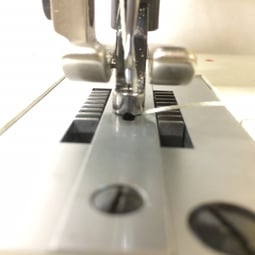
- Make sure the inner presser foot is not being rubbed by the needle
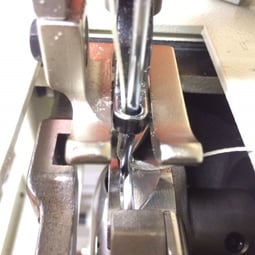
- Bank check the tension from the thread have-upwards spring. The spring should pull the thread back easily and quickly after pulling through the machine and releasing from one'southward mitt.
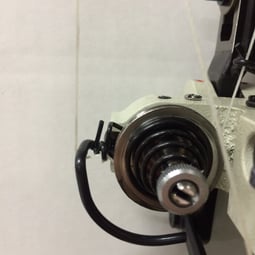
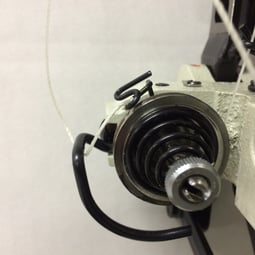
- Check thread tension on both summit and lesser thread. Thread coming from the bobbin should exist easy to pull from the case through the throat plate. Thread coming from the spool should be easy to pull from the operator'due south side of the have-up lever. Excess tension tin can cause improper loop formation.
- If skipping in ane direction, bank check that the pharynx plate is not installed 180° off. Try sewing with the pharynx plate turned 180°. If skipping in that direction persists, the problem is elsewhere. If skipping changes direction, change the throat plate or if skipping is happening on the shorter side of the throat plate, lengthen the slot on that side. Beneath is a picture of a brand new pharynx plate:
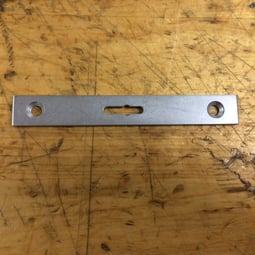
- Ensure that the feed dogs are not trying to movement material just as the needle clears. If feed dogs elevator and moves material too early, the thread will grab in the race or volition non cinch tightly. If it stays in the race, it could cause a skipped run up on the side by side stitch or cut threat.
- Check that the needle bar is not bent. This requires taking the needle bar out of the machine. Observe a very flat surface and lay the bar on it. Place manus on bar at about one third of the bar's length. Scroll the bar forward and back while watching the longer side for any wobble. Repeat for other side.
If problem persists and none of the points in a higher place resolve the issue, contact Service Thread for a consultation.

Related Manufactures:
- Sewing machines for industrial applications
- How to choose the correct needle size for industrial sewing
- Bonded versus soft industrial sewing threads
 Are skipped stitches causing yous downward fourth dimension in your industrial sewing application? Hither are some tips to help find and correct the common causes of skipped stitches.
Are skipped stitches causing yous downward fourth dimension in your industrial sewing application? Hither are some tips to help find and correct the common causes of skipped stitches. 












0 Response to "How To Repair Industrial Sewing Machine"
Post a Comment